Ban Gioc–Detian Falls
Bản Giốc – Detian Falls or Bản Giốc Falls is a collective name for two waterfalls on the Quây Sơn River (Vietnamese: Sông Quây Sơn, chữ Nôm: 滝𡇸山; Chinese: 归春河, Pinyin: Guīchūn hé) that straddle the international border between China and Vietnam; more specifically located between the Karst hills of Daxin County, Guangxi and Trùng Khánh District, Cao Bằng Province. The waterfalls are located 272 km (169 mi) north of Hanoi.
| Bản Giốc – Detian Falls | |
|---|---|
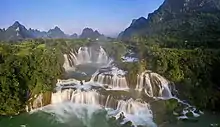 Bản Giốc – Detian Falls | |
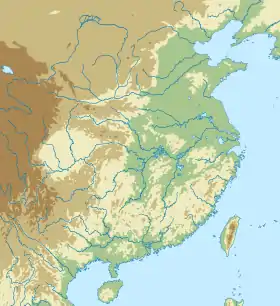 Location in Eastern China 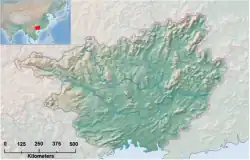 Location in Guangxi Zhuang Autonomous Region, China  Location in Vietnam | |
| Coordinates | 22°51′23″N 106°43′19″E |
| Watercourse | Quây Sơn River |
| Ban Gioc–Detian Falls | |||||||||||
|---|---|---|---|---|---|---|---|---|---|---|---|
| Chinese name | |||||||||||
| Traditional Chinese | 板約瀑布 | ||||||||||
| Simplified Chinese | 板约瀑布 | ||||||||||
| |||||||||||
| Alternative Chinese name | |||||||||||
| Chinese | 德天瀑布 | ||||||||||
| |||||||||||
| Vietnamese name | |||||||||||
| Vietnamese alphabet | Thác Bản Giốc (Bản Ước) Cặp thác Bản Giốc (Bản Ước) - Đức Thiên | ||||||||||
| Hán-Nôm | 𣴜岅篤(板約) 𬥠𣴜岅篤(板約)— 德天 | ||||||||||
Characteristics
Over thousands of years, the waterfall has eroded its crest and slowly moved upstream. It currently appears to be two waterfalls most of the time, but when the river is swollen due to summer rains can form one fall again.
In Vietnamese, the two falls are considered as two parts of one waterfall with the sole name Bản Giốc. The two parts are thác chính (Main waterfall) and thác phụ (Subordinate waterfall). Chinese texts sometimes name both of the water falls as Détiān Falls (Chinese: 德天瀑布) on the Chinese side.[1]
The waterfall drops 30 m (98 ft). It is separated into three falls by rocks and trees, and the thundering effect of the water hitting the cliffs can be heard from afar.[2]
It is currently the 4th largest waterfall along a national border, after Iguazu Falls, Victoria Falls, and Niagara Falls.[3] Somewhat nearby is the 1,000 m (3,300 ft) long by 200 m (660 ft) wide Tongling Gorge (Tōnglíng dàxiágǔ 通灵大峽谷 "Tongling Grand Canyon") in Baise City (百色市), Guangxi province, accessible only through a cavern from an adjoining gorge. Rediscovered only recently, it has many species of endemic plants, found only in the gorge.
Geology
The waterfalls are located in an area of mature karst formations where the original limestone bedrock layers are being eroded. Numerous streams spring from underground fissures along the lower levels of the area. The waterfalls have multiple drops, from bedrock layer to layer, which shows the multiple depositions of sediments of different hardness which formed the terrain over millions of years.
History
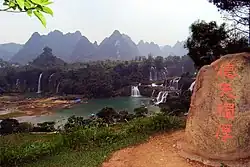
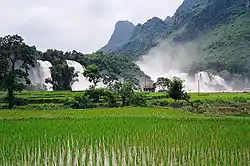
A road running along the top of the falls leads to a stone marker that demarcates the border between China and Vietnam in French and Chinese. Modern disputes arose as there are discrepancies as to the correlating legal documents on border demarcation and the placement of markers between the French and Qing administrations in the 19th century.[4]
Disputes regarding the border demarcation at this location were settled in 1999 Viet Nam-China Treaty on Land Borderline. Additional talks were held as late as 2009 to clarify the treaty.[5] However, there are controversies regarding the border demarcation around the Falls. One faction holds that the entirety of these falls belongs to Vietnam, and that the stone tablet had been moved there some time during or after the brief Sino-Vietnamese war of 1979.[6] To the southeast, the land dispute also along the Sino-Vietnamese border also includes Nam Quan Gate (Ải Nam Quan) which the Vietnamese claimed as well. Historically,[7][8][9] Nam Quan Gate served as the border marker and entry point to Vietnam between Vietnam & China (hence there's also a Vietnamese historical saying,[10] that Vietnam stretched from Cape Cà Mau to Ải Nam Quan).
Impact on industry and commerce
The waterfalls increase the quality of life for people who live within the sound of the falls. A road running along the top of the falls leads to a stone marker that demarcates the border between China and Vietnam in French and Chinese. 20th century disputes could not be resolved where inaccuracies in documents, maps and descriptions that were made in the 19th century became difficult to differentiate. The disappearance or inaccurate replacement of markers and landmarks from time to time, and the varied patterns of transportation, settlement and land use from generation to generation, and the successive administrative differences throughout periods of war and strife led to both Vietnam and China understanding that exactly defining the border would increase prosperity in the long term.[4]
The commercial focus of the area directly around the falls will likely remain tourism.
Transport
There are two directional aspects to transport at a waterfall: (1) portage along the river's course; and (2) fording or rafting across the river. Bản Giốc–Detian Falls was one of the crossing points for Chinese forces during the Sino-Vietnamese War. Rafts are currently used to boat tourists closer to the falls and return them to their dock of origination.
Preservation efforts
Preservation of the resource may require future cooperation between the local communities by use of a perpetual joint oversight committee.
References
- 韩欣 中国名水 (Han Xin, Famous Waters of China) 2005 Volume 2 "德天瀑布位于广西南宁地区边陲大新县,在中越边境交界处.归春河上游,瀑布气势磅薄、银瀑飞泻.三级跌落,蔚为 ... 夏季,德天瀑布和板约瀑布会连在一起,应该是整个德天风景区一道最为奇特的景观。它们浩浩荡荡地飞奔而下,像是凭空而降的一支巨大的 ..."
- "Cao Bang - the land of mountains and water". Archived from the original on 2022-09-01. Retrieved 2007-02-13.
- "Top 10 most beautiful Chinese waterfalls". China Central Television. Archived from the original on 2016-03-03. Retrieved 2011-11-12.
- Vietnamese Embassy: On the settlement of Vietnam-China border issue vietnamembassy-usa.org
- "Vietnam and China's land demarcation itinerary". Archived from the original on 2012-05-31. Retrieved 2011-12-12.
- The implementation of Vietnam-China land border treaty: bilateral and regional implications. Do Thi Thuy 5/3/2009 PDF Archived 2018-08-10 at the Wayback Machine
- Han Nam Quan 3 (English) Archived 2014-08-31 at the Wayback Machine
- "In Westminster, an Internet Bid to Restore Viet Land" Los Angeles Times
- "Interview On Territory And Territorial Waters - General". Archived from the original on 2015-01-12. Retrieved 2012-10-17.
- "Asia Finest Discussion Forum > Ai Nam Quan - An example of communist sellout of Motherland". Archived from the original on 2014-02-22. Retrieved 2012-10-17.
External links
- Cao Bằng Provincial Government website (English version)
- Falls photo gallery
